文章目录
- 第07章_面向对象编程(进阶)拓展练习
- 01-关键字:this
- 1、Circle类
- 2、MyDate类
- 3、Card类
- 02-继承性和方法重写
- 4、Person、Student、Teacher类
- 5、DepositCard、CreditCard类
- 6、Employee、Programmer、Designer、Architect类
- 7、判断输出结果
- 03-关键字:super
- 8、判断运行结果
- 9、判断运行结果
- 10、判断运行结果
- 11、判断运行结果
- 12、判断运行结果
- 13、判断运行结果
- 14、是否可通过编译
- 15、Person、Student、Teacher类
- 05-多态性
- 16、Graphic、Circle、Rectangle类
- 17、Employee、SalaryEmployee、HourEmployee、Manager类
- 18、Person、Man、Woman等类
- 19、Person、Man、Woman类及数组
- 20、普通员工、程序员、设计师、架构师
- 21、判断运行结果
- 22、判断运行结果
- 23、判断运行结果
- 24、判断运行结果
- 25、判断运行结果
- 26、判断运行结果
- 27、判断运行结果
- 28、判断运行结果
- 29、判断运行结果
- 30、判断运行结果
- 31、判断运行结果
- 32、判断运行结果
- 06-Object类
- 33、Triangle类
第07章_面向对象编程(进阶)拓展练习
01-关键字:this
1、Circle类
-
在com.atguigu.exercise1.bean包中定义一个圆形Circle类。
- 属性:私有化
- r:半径
- 构造方法:
- 无参构造方法
- 满参构造方法
- 成员方法:
- get/set方法
- showArea方法:打印圆形面积
- showPerimeter方法:打印圆形周长
- 属性:私有化
-
在com.atguigu.test01.test包中定义测试类TestCircle:创建Circle对象,并测试。
package com.atguigu.exercise1.bean;public class Circle {private double radius;public Circle(double radius) {this.radius = radius;}public Circle() {}public double getRadius() {return radius;}public void setRadius(double radius) {this.radius = radius;}public void showArea(){System.out.println("半径为:" + radius + ",面积:" + 3.14 * radius * radius);}public void showPerimeter(){System.out.println("半径为:" + radius + ",周长:" + 2 * 3.14 * radius);}
}public class Exercise1 {public static void main(String[] args) {Circle c1 = new Circle(1.2);c1.showArea();c1.showPerimeter();}
}2、MyDate类
-
在com.atguigu.test02.bean包中定义一个日期MyDate类。
- 属性:
- year:年
- month:月
- day:日
- 构造方法:
- 包含year、month、day三个参数的构造方法
- 成员方法:
- get/set方法
- void showDate方法:打印日期。“日期:xxx年xx月xx日”
- boolean isLeapYear()方法:判断当前日期是否是闰年
- 属性:
-
在com.atguigu.test02.test包中定义测试类:创建MyDate对象,并测试。
-
代码实现,效果如图所示:

-
提示:
- 闰年:能被4整除且不能被100整除; 能被400整除
public class MyDate {private int year;private int month;private int day;public MyDate() {}public MyDate(int year, int month, int day) {this.year = year;this.month = month;this.day = day;}public int getYear() {return year;}public void setYear(int year) {this.year = year;}public int getMonth() {return month;}public void setMonth(int month) {this.month = month;}public int getDay() {return day;}public void setDay(int day) {this.day = day;}public void showDate() {System.out.println("日期:" + year + "年" + month + "月" + day + "日");}public boolean isLeapYear() {return year % 4 == 0 && year % 100 != 0 || year % 400 == 0;}
}public class Exercise2 {public static void main(String[] args) {MyDate my = new MyDate(2019,5,13);my.showDate();boolean flag = my.isLeapYear();System.out.println(my.getYear()+ (flag?"是闰年":"不是闰年"));}
}3、Card类
-
在com.atguigu.test03.bean包中定义一个扑克Card类。
- 属性:
- 花色(String hua)
- 点数(String dian)
- 构造方法:
- 包含hua、dian两个参数的构造方法
- 成员方法:
- showCard方法:打印牌面信息。比如:红桃K
- 属性:
-
在com.atguigu.test03.test包中定义测试类,创建Card对象,调用showCard方法。
public class Card {private String hua;private String dian;public Card(String hua, String dian) {this.hua = hua;this.dian = dian;}public Card() {}public String getHua() {return hua;}public void setHua(String hua) {this.hua = hua;}public String getDian() {return dian;}public void setDian(String dian) {this.dian = dian;}public void showCard() {System.out.println(hua + dian);}
}public class Exercise3 {public static void main(String[] args) {Card c = new Card("黑桃", "A");c.showCard();}
}02-继承性和方法重写
4、Person、Student、Teacher类
(1)声明父类:Person类
- 包含属性:姓名,年龄,性别,属性私有化,
- 包含get/set方法
- 包含getInfo()方法:例如:姓名:张三,年龄:23,性别:男
(2)声明子类:Student类,继承Person类
- 新增属性:score成绩,属性私有化,
- 包含get/set方法
- 重写getInfo()方法:例如:姓名:张三,年龄:23,性别:男,成绩:89
(3)声明子类:Teacher类,继承Person类
- 新增属性:salary薪资,属性私有化,
- 包含get/set方法
- 重写getInfo()方法:例如:姓名:张三,年龄:23,性别:男,薪资:10000
(4)在测试类的main方法中创建三个类的对象,并调用相应的方法测试
public class Person {private String name;private int age;private char gender;public String getName() {return name;}public void setName(String name) {this.name = name;}public int getAge() {return age;}public void setAge(int age) {this.age = age;}public char getGender() {return gender;}public void setGender(char gender) {this.gender = gender;}public String getInfo() {return "姓名:" + name + ",年龄:" + age + ",性别:" + gender;}
}
public class Student extends Person {private int score;public int getScore() {return score;}public void setScore(int score) {this.score = score;}@Overridepublic String getInfo(){//方式一:
// return "姓名:" + getName() + ",年龄:" + getAge() + ",性别:" + getGender() + ",成绩:" + score;//方法二:return super.getInfo() + ",成绩:" + score;}}
public class Teacher extends Person {private double salary;public double getSalary() {return salary;}public void setSalary(double salary) {this.salary = salary;}@Overridepublic String getInfo(){return super.getInfo() + ",薪资:" + salary;}
}
public class Exercise4 {public static void main(String[] args) {Person p = new Person();p.setName("张三");p.setAge(23);p.setGender('男');System.out.println(p.getInfo());Student s = new Student();s.setName("王浩");s.setAge(20);s.setGender('男');s.setScore(90);System.out.println(s.getInfo());Teacher t = new Teacher();t.setName("宋红康");t.setAge(36);t.setGender('男');t.setSalary(50000);System.out.println(t.getInfo());}
}
5、DepositCard、CreditCard类
(1)声明一个银行储蓄卡DepositCard类
- 包含属性:账户,余额,属性私有化
- 包含get/set方法
- public void withdraw(double money):取款,
- 取款金额不能为负数,否则提示取款金额不能为负数
- 取款金额不能超过账户余额,否则提示余额不足
- public void save(double money):存款,
- 存款金额不能为负数,否则提示存款金额不能为负数
- public String getInfo() 可以返回账户和余额
(2)声明一个银行信用卡CreditCard类,继承储蓄卡类
-
增加属性:本月可透支总额度,本月已透支金额
-
重写public void withdraw(double money),可透支,
- 取款金额超过账户余额+本月还可透支额度,提示超过可透支额度
- 取款金额在账户余额范围内,不用透支
- 取款金额超过账户余额但在可透支范围内,需要透支
-
重写public void save(double money),
- 存款金额不能为负数,否则提示存款金额不能为负数
- 本次存款金额只够偿还部分已透支金额
- 本次存款金额除了偿还透支金额,还有剩余
(3)在测试类中,分别创建两种卡对象,测试
public class DepositCard {private String id;private double balance;public String getId() {return id;}public void setId(String id) {this.id = id;}public double getBalance() {return balance;}public void setBalance(double balance) {this.balance = balance;}public void withdraw(double money){if(money<0){System.out.println("取款金额不能为负数");return;}if(money>balance){System.out.println("余额不足");return;}balance -= money;}public void save(double money){if(money<0){System.out.println("存款金额不能为负数");return;}balance += money;}public String getInfo(){return "账号:" + id + ",余额:" + balance;}
}
public class CreditCard extends DepositCard {private double maxOverdraft;//当月最多可以透支额度private double overdraft;//本月已透支额度public double getMaxOverdraft() {return maxOverdraft;}public void setMaxOverdraft(double maxOverdraft) {this.maxOverdraft = maxOverdraft;}public double getOverdraft() {return overdraft;}public void setOverdraft(double overdraft) {this.overdraft = overdraft;}@Overridepublic void withdraw(double money) {//超过可透支额度if(money > getBalance() + maxOverdraft - overdraft){System.out.println("超过可透支额度");return;}//不用透支if(money <= getBalance()){super.withdraw(money);return;}//需要透支overdraft += money - getBalance();setBalance(0);}@Overridepublic void save(double money) {if(money < 0){System.out.println("存款金额不能为负数");return;}//偿还部分透支金额if(money <= overdraft){overdraft -= money;return;}//偿还所有透支金额,还有剩余setBalance(getBalance() + (money - overdraft));overdraft = 0;}@Overridepublic String getInfo() {return super.getInfo() +",本月可透支总额度:" + maxOverdraft + ",本月已透支:" + overdraft +",本月还可透支:" + (maxOverdraft - overdraft);}
}//测试1
public class Exercise5 {public static void main(String[] args) {DepositCard d = new DepositCard();d.setId("11111");d.setBalance(500);System.out.println("初始情况:" + d.getInfo());d.withdraw(200);System.out.println("取款200后:" + d.getInfo());d.save(100);System.out.println("存款100后:" + d.getInfo());d.save(-100);System.out.println("存款-100后:" + d.getInfo());d.withdraw(-100);System.out.println("取款-100后:" + d.getInfo());d.withdraw(500);System.out.println("取款500后:" + d.getInfo());}
}
//测试2
public class Exercise5 {public static void main(String[] args) {CreditCard d = new CreditCard();d.setId("11111");d.setBalance(500);d.setMaxOverdraft(1000);System.out.println("初始情况:" + d.getInfo());d.withdraw(200);System.out.println("取款200后:" + d.getInfo());d.withdraw(800);System.out.println("取款800后:" + d.getInfo());d.withdraw(500);System.out.println("取款500后:" + d.getInfo());d.save(100);System.out.println("存款100后:" + d.getInfo());d.save(-100);System.out.println("存款-100后:" + d.getInfo());d.withdraw(-100);System.out.println("取款-100后:" + d.getInfo());d.withdraw(500);System.out.println("取款500后:" + d.getInfo());d.save(2000);System.out.println("存款2000后:" + d.getInfo());}
}
6、Employee、Programmer、Designer、Architect类
1、在包中声明员工类、程序员类、设计师类、架构师类
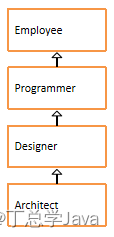
- 员工类属性:编号、姓名、年龄、手机号码
- 程序员类属性:编程语言
- 设计师类属性:奖金
- 架构师类属性:持有股票数量
要求:属性私有化,无参有参构造,get/set,getInfo方法(考虑重写)
2、在包中声明测试类Exercise6
创建各种类的对象,并测试
public class Employee {private int id;private String name;private int age;private String tel;public Employee() {super();}public Employee(int id, String name, int age, String tel) {super();this.id = id;this.name = name;this.age = age;this.tel = tel;}public int getId() {return id;}public void setId(int id) {this.id = id;}public String getName() {return name;}public void setName(String name) {this.name = name;}public int getAge() {return age;}public void setAge(int age) {this.age = age;}public String getTel() {return tel;}public void setTel(String tel) {this.tel = tel;}public String getInfo(){return "编号:" + name + ",姓名:" + name + ",年龄:" + age + ",电话:" + tel;}
}public class Programmer extends Employee{private String language;public Programmer() {super();}public Programmer(int id, String name, int age, String tel, String language) {super(id, name, age, tel);this.language = language;}public String getLanguage() {return language;}public void setLanguage(String language) {this.language = language;}@Overridepublic String getInfo() {return super.getInfo() + ",编程语言:" + language;}
}
public class Designer extends Programmer {private double bonus;public Designer() {super();}public Designer(int id, String name, int age, String tel, String language, double bonus) {super(id, name, age, tel, language);this.bonus = bonus;}public double getBonus() {return bonus;}public void setBonus(double bonus) {this.bonus = bonus;}@Overridepublic String getInfo() {return super.getInfo() + ",奖金:" + bonus;}}public class Architect extends Designer {private int stock;public Architect() {super();}public Architect(int id, String name, int age, String tel, String language, double bonus, int stock) {super(id, name, age, tel, language, bonus);this.stock = stock;}public int getStock() {return stock;}public void setStock(int stock) {this.stock = stock;}@Overridepublic String getInfo() {return super.getInfo() + ",持有股票数:" + stock;}
}
public class Exercise6 {public static void main(String[] args) {Employee emp = new Employee(1, "张三", 23, "10086");Programmer pro = new Programmer(2, "李四", 24, "10010", "java");Designer de = new Designer(3, "王五", 25, "114", "python", 2000);Architect a = new Architect(4, "赵六", 26, "110", "java", 3000, 100);System.out.println(emp.getInfo());System.out.println(pro.getInfo());System.out.println(de.getInfo());System.out.println(a.getInfo());}
}7、判断输出结果
public class Exercise7 {public static void main(String[] args) {Father f = new Father();Son s = new Son();System.out.println(f.getInfo());System.out.println(s.getInfo());s.setInfo("尚硅谷");System.out.println(f.getInfo());System.out.println(s.getInfo());}
}
class Father{private String info = "atguigu";public void setInfo(String info){this.info = info;}public String getInfo(){return info;}
}
class Son extends Father{}
/*
1、私有的属性是否可以被继承到子类中?
(1)如果从可以访问性的角度来说:不能,因为在子类中不能直接访问父类的私有的属性,但是可以通过get/set操作
(2)如果从类的概念来说,
类是一类具有相同特性(属性、方法等)的事物的抽象描述,
那么子类是从父类派生出来的,那么子类是有父类的这个特征的,即有这个属性的2、每一个对象的非静态属性是独立的,其中一个对象修改和另一个对象是无关的*/
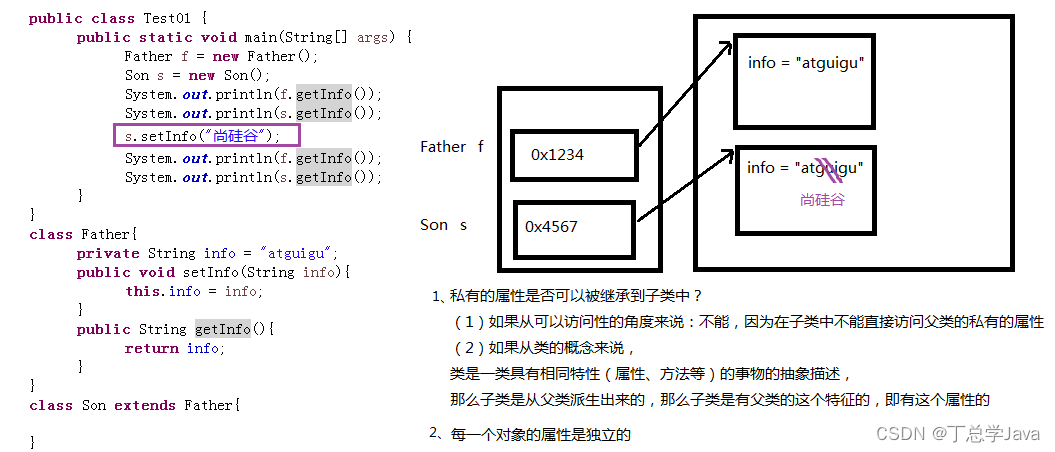
03-关键字:super
8、判断运行结果
public class Exercise8 {public static void main(String[] args) {new Child("mike");}
}class People {private String name;public People() {System.out.print("1");}public People(String name) {System.out.print("2");this.name = name;}
}class Child extends People {People father;public Child(String name) {System.out.print("3");father = new People(name + " F");}public Child() {System.out.print("4");}
}9、判断运行结果
public class Exercise9 {public static void main(String[] args) {Father f = new Father();Child c = new Child();}
}
class Father {public Father(){System.out.println("father()...");}
}
class Child extends Father{public Child(){System.out.println("child()...");}
}
10、判断运行结果
public class Exercise10 {public static void main(String[] args) {new A(new B());}
}class A {public A() {System.out.println("A");}public A(B b) {this();System.out.println("AB");}
}class B {public B() {System.out.println("B");}
}11、判断运行结果
public class Son extends Father{private String name = "son";public static void main(String[] args) {Son son = new Son();System.out.println(son.getName());}
}
class Father {private String name = "father";public String getName() {return name;}
}
/** 当父类与子类有同名的属性时:* 通过子类对象调用getName()访问的是父类的name还是子类的name,* 那么要看子类是否重写,如果没有重写,就是父类的,重写了就是子类的。*/
12、判断运行结果
public class Exercise12 {public static void main(String[] args) {Father f = new Father();Son s = new Son();System.out.println(f.getInfo());System.out.println(s.getInfo());s.test();System.out.println("-----------------");s.setInfo("大硅谷");System.out.println(f.getInfo());System.out.println(s.getInfo());s.test();}
}
class Father{private String info = "atguigu";public void setInfo(String info){this.info = info;}public String getInfo(){return info;}
}
class Son extends Father{private String info = "尚硅谷";public void test(){System.out.println(this.getInfo());System.out.println(super.getInfo());}
}
/*
1、私有的属性是否可以被继承到子类中?
(1)如果从可以访问性的角度来说:不能,因为在子类中不能直接访问父类的私有的属性,但是可以通过get/set操作
(2)如果从类的概念来说,
类是一类具有相同特性(属性、方法等)的事物的抽象描述,
那么子类是从父类派生出来的,那么子类是有父类的这个特征的,即有这个属性的2、每一个对象的非静态属性是独立的,其中一个对象修改和另一个对象是无关的3、当子类有与父类的属性同名时,那么通过子类对象调用get/set方法操作的是父类继承还是子类自己的属性呢?
要看子类是否重写:
如果没有重写,操作的都是父类的,不管是直接getInfo()还是this.getInfo(),还是super.getInfo()
如果重写了,如果通过子类对象调用,操作的是子类的,例如:getInfo()还是this.getInfo(),如果通过super.调用的,操作的是父类的。*/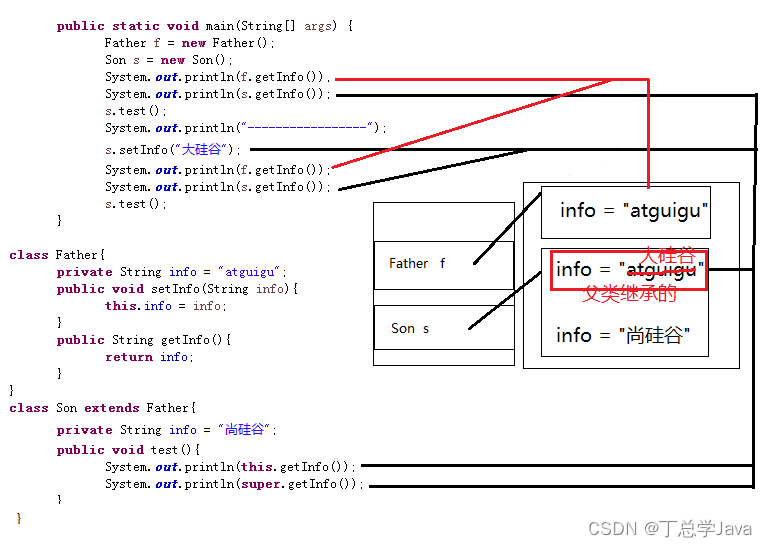
13、判断运行结果
public class Exercise13 {public static void main(String[] args) {Father f = new Father();Son s = new Son();System.out.println(f.getInfo());System.out.println(s.getInfo());s.test();System.out.println("-----------------");s.setInfo("大硅谷");System.out.println(f.getInfo());System.out.println(s.getInfo());s.test();}
}
class Father{private String info = "atguigu";public void setInfo(String info){this.info = info;}public String getInfo(){return info;}
}
class Son extends Father{private String info = "尚硅谷";public void setInfo(String info){this.info = info;}public String getInfo(){return info;}public void test(){System.out.println(this.getInfo());System.out.println(super.getInfo());}
}
/*
1、私有的属性是否可以被继承到子类中?
(1)如果从可以访问性的角度来说:不能,因为在子类中不能直接访问父类的私有的属性,但是可以通过get/set操作
(2)如果从类的概念来说,
类是一类具有相同特性(属性、方法等)的事物的抽象描述,
那么子类是从父类派生出来的,那么子类是有父类的这个特征的,即有这个属性的2、每一个对象的非静态属性是独立的,其中一个对象修改和另一个对象是无关的3、当子类有与父类的属性同名时,那么通过子类对象调用get/set方法操作的是父类继承还是子类自己的属性呢?
要看子类是否重写:
如果没有重写,操作的都是父类的,不管是直接getInfo()还是this.getInfo(),还是super.getInfo()
如果重写了,如果通过子类对象调用,操作的是子类的,例如:getInfo()还是this.getInfo(),如果通过super.调用的,操作的是父类的。*/
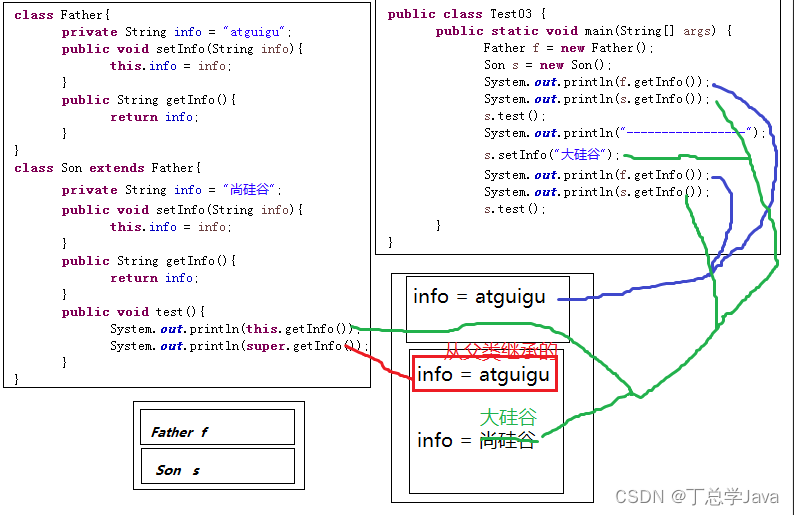
14、是否可通过编译
如下代码是否可以编译通过,如果能,结果是什么,如果不能,为什么?
public class Person{public Person(){System.out.println("this is a Person.");}
}
public class Teacher extends Person{private String name = "tom";public Teacher(){System.out.println("this is a teacher.");super();}public static void main(String[] args){Teacher tea = new Teacher();System.out.println(this.name);}
}
剖析:
public class Teacher extends Person{private String name = "tom";public Teacher(){System.out.println("this is a teacher.");
// super();//错误,super()必须在构造器首行}public static void main(String[] args){Teacher tea = new Teacher();
// System.out.println(this.name);//错误,static方法中不能使用this}
}15、Person、Student、Teacher类
(1)声明父类:Person类
- 包含属性:姓名,年龄,性别,属性私有化
- 包含get/set方法
- 提供无参构造public Person()
- 提供有参构造public Person(String name, int age, char gender)
- 包含getInfo()方法:例如:姓名:张三,年龄:23,性别:男
(2)声明子类:Student类,继承Person类
- 新增属性:score成绩,属性私有化
- 包含get/set方法
- 提供无参构造public Student()
- 提供有参构造public Student(String name, int age, char gender, int score)
- 重写getInfo()方法:例如:姓名:张三,年龄:23,性别:男,成绩:89
(3)声明子类:Teacher类,继承Person类
- 新增属性:salary薪资,属性私有化
- 包含get/set方法
- 提供无参构造public Teacher()
- 提供有参构造public Teacher(String name, int age, char gender, double salary)
- 重写getInfo()方法:例如:姓名:张三,年龄:23,性别:男,薪资:10000
(4)在测试类的main方法中用有参构造创建三个类的对象,并调用相应的方法测试
public class Person {private String name;private int age;private char gender;public Person() {}public Person(String name, int age, char gender) {this.name = name;this.age = age;this.gender = gender;}public String getName() {return name;}public void setName(String name) {this.name = name;}public int getAge() {return age;}public void setAge(int age) {this.age = age;}public char getGender() {return gender;}public void setGender(char gender) {this.gender = gender;}public String getInfo() {return "姓名:" + name + ",年龄:" + age + ",性别:" + gender;}
}public class Student extends Person {private int score;public Student() {}public Student(String name, int age, char gender, int score) {super(name, age, gender);this.score = score;}public int getScore() {return score;}public void setScore(int score) {this.score = score;}@Overridepublic String getInfo(){return super.getInfo() + ",成绩:" + score;}
}
public class Teacher extends Person {private double salary;public Teacher() {}public Teacher(String name, int age, char gender, double salary) {super(name, age, gender);this.salary = salary;}public double getSalary() {return salary;}public void setSalary(double salary) {this.salary = salary;}@Overridepublic String getInfo(){return super.getInfo() + ",薪资:" + salary;}
}
public class Exercise15 {public static void main(String[] args) {Person p = new Person("张三",23,'男');System.out.println(p.getInfo());Student s = new Student("王浩",20,'男',90);System.out.println(s.getInfo());Teacher t = new Teacher("宋红康",37,'男',50000);System.out.println(t.getInfo());}
}
05-多态性
16、Graphic、Circle、Rectangle类
(1)父类Graphic图形
- public double area()方法:返回0.0
- public double perimeter()方法:返回0.0
- public String getInfo()方法,返回图形面积和图形周长
(2)子类Circle圆类继承Graphic图形
- 包含属性:radius,属性私有化
- 包含get/set方法
- 重写area()求面积方法
- 重写perimeter()求周长方法
- 重写getInfo()方法,返回圆的半径,面积和周长
(3)子类矩形Rectangle继承Graphic图形
- 包含属性:length、width,属性私有化
- 包含get/set方法
- 重写area()求面积方法
- 重写perimeter()求周长方法
- 重写getInfo()方法,返回长和宽,面积、周长信息
(4)在测试类的main方法中创建多个圆和矩形对象放到Graphic[]类型的数组中,并按照面积从小到大排序输出。
public class Graphic {public double area(){return 0.0;}public double perimeter(){return 0.0;}public String getInfo() {return "面积:" + area() + ",周长:" + perimeter();}
}
public class Rectangle extends Graphic{private double length;private double width;public double getLength() {return length;}public void setLength(double length) {this.length = length;}public double getWidth() {return width;}public void setWidth(double width) {this.width = width;}@Overridepublic double area(){return length * width;}@Overridepublic double perimeter(){return 2 * (length + width);}@Overridepublic String getInfo() {return "矩形长:" + length + ",宽:" + width +"," + super.getInfo();}
}public class Circle extends Graphic{private double radius;public double getRadius() {return radius;}public void setRadius(double radius) {this.radius = radius;}@Overridepublic double area(){return Math.PI * radius * radius;}@Overridepublic double perimeter(){return 2 * Math.PI * radius;}@Overridepublic String getInfo() {return "圆半径:" + radius +"," + super.getInfo();}
}public class Exercise16 {public static void main(String[] args) {//用一个数组用来存储各种图形的对象,并且按照各种图形的面积进行排序Circle c1 = new Circle();c1.setRadius(2.5);Circle c2 = new Circle();c2.setRadius(1.5);Rectangle r1 = new Rectangle();r1.setLength(5);r1.setWidth(1);Rectangle r2 = new Rectangle();r2.setLength(4);r2.setWidth(2);Graphic[] shapes = new Graphic[4];shapes[0] = c1;shapes[1] = c2;shapes[2] = r1;shapes[3] = r2;System.out.println("排序前:");for (int i = 0; i < shapes.length; i++) {System.out.println(shapes[i].getInfo());}//按照面积排序for (int i = 1; i < shapes.length; i++) {for (int j = 0; j < shapes.length - i; j++) {if(shapes[j].area() > shapes[j+1].area()){Graphic temp = shapes[j];shapes[j] = shapes[j+1];shapes[j+1] = temp;}}}System.out.println("排序后:");for (int i = 0; i < shapes.length; i++) {System.out.println(shapes[i].getInfo());}}
}
17、Employee、SalaryEmployee、HourEmployee、Manager类
(1)声明一个父类Employee员工类型,
- 有姓名属性,私有化,提供get/set方法
- 提供有参构造public Employee(String name)
- public double earning():代表实发工资,返回0.0
- public String getInfo():显示姓名和实发工资
(2)声明MyDate类型
- 有int类型的年,月,日属性,私有化,提供get/set方法
- 提供有参构造public MyDate(int year, int month, int day)
- 提供public String getInfo(),返回“xxxx年xx月xx日”
(3)声明一个子类SalaryEmployee正式工,继承父类Employee
- 增加属性,double类型的薪资,MyDate类型的出生日期,私有化,提供get/set方法
- 提供有参构造public SalaryEmployee(String name, double salary, MyDate birthday)
- 提供有参构造public SalaryEmployee(String name,double salary, int year, int month ,int day)
- 重写方法,public double earning()返回实发工资, 实发工资 = 薪资
- 重写方法,public String getInfo():显示姓名和实发工资、生日
(4)声明一个子类HourEmployee小时工,继承父类Employee
- 有属性,double类型的工作小时数和每小时多少钱
- 提供有参构造public HourEmployee(String name, double moneyPerHour)
- 提供有参构造public HourEmployee(String name, double moneyPerHour, double hour)
- 重写方法,public double earning()返回实发工资, 实发工资 = 每小时多少钱 * 小时数
- 重写方法,public String getInfo():显示姓名和实发工资,时薪,工作小时数
(5)声明一个子类Manager经理,继承SalaryEmployee
- 增加属性:奖金比例,私有化,提供get/set方法
- 提供有参构造public Manager(String name, double salary, MyDate birthday, double bonusRate)
- 提供有参构造public Manager(String name,double salary, int year, int month ,int day, double bonusRate)
- 重写方法,public double earning()返回实发工资, 实发工资 = 薪资 *(1+奖金比例)
- 重写方法,public String getInfo():显示姓名和实发工资,生日,奖金比例
(6)声明一个员工数组,存储各种员工,你现在是人事,遍历查看每个人的详细信息,并统计实发工资总额,通知财务准备资金。
(7)从键盘输入当期月份值,如果他是正式工(包括SalaryEmployee和Manager),并且是本月生日的,通知领取生日礼物。
public class Employee {private String name;public Employee(String name) {this.name = name;}public String getName() {return name;}public void setName(String name) {this.name = name;}public double earning(){return 0.0;}public String getInfo(){return "姓名:" + name + ",实发工资:" + earning();}
}public class MyDate {private int year;private int month;private int day;public MyDate(int year, int month, int day) {this.year = year;this.month = month;this.day = day;}public int getYear() {return year;}public void setYear(int year) {this.year = year;}public int getMonth() {return month;}public void setMonth(int month) {this.month = month;}public int getDay() {return day;}public void setDay(int day) {this.day = day;}public String getInfo(){return year + "年" + month + "月" + day +"日";}
}public class SalaryEmployee extends Employee {private double salary;private MyDate birthday;public SalaryEmployee(String name, double salary, MyDate birthday) {super(name);this.salary = salary;this.birthday = birthday;}public SalaryEmployee(String name, double salary,int year, int month, int day) {super(name);this.salary = salary;this.birthday = new MyDate(year, month ,day);}public double getSalary() {return salary;}public void setSalary(double salary) {this.salary = salary;}public MyDate getBirthday() {return birthday;}public void setBirthday(MyDate birthday) {this.birthday = birthday;}@Overridepublic double earning() {return salary;}@Overridepublic String getInfo() {return super.getInfo() +",生日:" + birthday.getInfo();}
}public class HourEmployee extends Employee {private double hour;private double moneyPerHour;public HourEmployee(String name, double hour) {super(name);this.hour = hour;}public HourEmployee(String name, double hour, double moneyPerHour) {super(name);this.hour = hour;this.moneyPerHour = moneyPerHour;}public double getHour() {return hour;}public void setHour(double hour) {this.hour = hour;}public double getMoneyPerHour() {return moneyPerHour;}public void setMoneyPerHour(double moneyPerHour) {this.moneyPerHour = moneyPerHour;}@Overridepublic double earning() {return hour * moneyPerHour;}@Overridepublic String getInfo() {return super.getInfo() +",时薪:" + moneyPerHour +",工作小时数:" + hour;}
}public class Manager extends SalaryEmployee {private double bonusRate;public Manager(String name, double salary, MyDate birthday, double bonusRate) {super(name, salary, birthday);this.bonusRate = bonusRate;}public Manager(String name, double salary, int year, int month, int day, double bonusRate) {super(name, salary, year, month, day);this.bonusRate = bonusRate;}public double getBonusRate() {return bonusRate;}public void setBonusRate(double bonusRate) {this.bonusRate = bonusRate;}@Overridepublic double earning() {return super.earning() * (1 + bonusRate);}@Overridepublic String getInfo() {return super.getInfo() +",奖金比例:" + bonusRate;}
}public class Exercise17 {public static void main(String[] args) {Employee[] all = new Employee[3];all[0] = new SalaryEmployee("张三",15000,new MyDate(1995,5,1));all[1] = new Manager("老王",20000,1990,6,1,0.1);all[2] = new HourEmployee("李四",50,100);double sum = 0;for (int i = 0; i < all.length; i++) {System.out.println(all[i].getInfo());sum += all[i].earning();}System.out.println("实发工资总额:" + sum);Scanner input = new Scanner(System.in);System.out.print("请输入月份:");int month = input.nextInt();for (int i = 0; i < all.length; i++) {if(all[i] instanceof SalaryEmployee){SalaryEmployee s = (SalaryEmployee) all[i];if(s.getBirthday().getMonth() == month){System.out.println(s.getName() + "生日快乐,请到人事部门领取生日大礼包");}}}input.close();}
}
18、Person、Man、Woman等类
案例:
1、在包中声明人Person、男人Man、女人Woman类
(1)在Person类中,包含
①public void eat():打印吃饭
②public void toilet():打印上洗手间
(2)在Man类中,包含
①重写上面的方法
②增加 public void smoke():打印抽烟
(3)在Woman类中,包含
①重写上面的方法
②增加 public void makeup():打印化妆
2、在包中声明测试类Test09
(1)public static void meeting(Person… ps)
在该方法中,每一个人先吃饭,然后上洗手间,然后如果是男人,随后抽根烟,如果是女人,随后化个妆
(2)public static void main(String[] args)
在主方法中,创建多个男人和女人对象,并调用meeting()方法进行测试
public class Person {public void eat(){System.out.println("吃饭");}public void toilet(){System.out.println("上洗手间");}
}public class Man extends Person{@Overridepublic void eat() {System.out.println("细嚼慢咽吃饭");}@Overridepublic void toilet() {System.out.println("站着上洗手间");}public void smoke(){System.out.println("抽烟爽爽");}
}public class Woman extends Person{@Overridepublic void eat() {System.out.println("狼吞虎咽吃饭");}@Overridepublic void toilet() {System.out.println("坐着上洗手间");}public void makeup(){System.out.println("化妆美美");}}public class Exercise18 {public static void main(String[] args) {meeting(new Woman(),new Man(), new Woman(), new Man());}public static void meeting(Person... ps){for (int i = 0; i < ps.length; i++) {ps[i].eat();ps[i].toilet();if(ps[i] instanceof Woman){((Woman)ps[i]).makeup();}else if(ps[i] instanceof Man){((Man)ps[i]).smoke();}}}
}
19、Person、Man、Woman类及数组
(1)在Person类中,包含
- 属性:姓名,年龄,职业
- public void eat():打印xx吃饭,xx代表姓名
- public void toilet():打印xx上洗手间
- public String getInfo():返回姓名、年龄、职业信息。
(2)在Man类中,包含
- 重写eat():xx狼吞虎咽吃饭
- 增加 public void smoke():打印xx抽烟
(3)在Woman类中,包含
- 重写eat():xx细嚼慢咽吃饭
- 增加 public void makeup():打印xx化妆
(4)周末一群男男女女相亲,在测试类创建不同对象放在Person[]数组中,
- 遍历数组,自我介绍,
- 再次遍历数组,调用吃饭方法
- 吃完饭,最后遍历数组,都去上厕所,男的上完厕所抽烟,女的上完厕所补妆。
public class Person {private String name;private int age;private String job;public String getName() {return name;}public void setName(String name) {this.name = name;}public int getAge() {return age;}public void setAge(int age) {this.age = age;}public String getJob() {return job;}public void setJob(String job) {this.job = job;}public void eat() {System.out.println(name + "吃饭");}public void toilet() {System.out.println(name + "上洗手间");}public String getInfo() {return "姓名:" + name + ",年龄:" + age + ",职业:" + job;}
}public class Man extends Person {@Overridepublic void eat() {System.out.println(getName() + "狼吞虎咽的吃饭");}public void smoke(){System.out.println(getName() + "抽烟");}
}public class Woman extends Person{@Overridepublic void eat() {System.out.println(getName() + "细嚼慢咽的吃饭");}public void makeup(){System.out.println(getName() + "化妆");}
}public class Exercise19 {public static void main(String[] args) {Person[] arr = new Person[4];arr[0] = new Man();arr[0].setName("张三");arr[0].setAge(23);arr[0].setJob("Java中级工程师");arr[1] = new Man();arr[1].setName("李四");arr[1].setAge(24);arr[1].setJob("大数据工程师");arr[2] = new Woman();arr[2].setName("翠花");arr[2].setAge(22);arr[2].setJob("UI设计师");arr[3] = new Woman();arr[3].setName("如花");arr[3].setAge(23);arr[3].setJob("前端设计师");System.out.println("------------初次见面--------------");for (int i = 0; i < arr.length; i++) {System.out.println(arr[i].getInfo());}System.out.println("-------------开始聚餐--------------");for (int i = 0; i < arr.length; i++) {arr[i].eat();}System.out.println("---------------饭后休息-------------");for (int i = 0; i < arr.length; i++) {arr[i].toilet();if(arr[i] instanceof Man){Man man = (Man) arr[i];man.smoke();}else if(arr[i] instanceof Woman){Woman woman = (Woman) arr[i];woman.makeup();}}}
}20、普通员工、程序员、设计师、架构师
(1)普通员工Employee类
- 包含编号、姓名、年龄、工资,属性私有化
- 提供无参构造
- 提供有参构造Employee(int id, String name, int age, double salary)
- 提供get/set方法
- 提供String say()方法:返回员工基本信息
- 提供String getInfo()方法:返回员工基本信息
(2)程序员Programmer类,继承普通员工类
- 提供无参构造
- 提供有参构造Programmer(int id, String name, int age, double salary)
- 重写String getInfo()方法,增加职位“程序员”信息
(3)设计师Designer类,继承程序员类
- 增加奖金属性
- 提供无参构造
- 提供有参构造Designer(int id, String name, int age, double salary, double bonus)
- 重写String getInfo()方法,增加职位“设计师”和奖金信息
(4)架构师Architect类,继承设计师类
- 增加股票属性
- 提供无参构造
- 提供有参构造Architect(int id, String name, int age, double salary, double bonus, int stock)
- 重写String getInfo()方法,增加职位“架构师”和奖金、股票信息
(5)在测试类中创建员工数组,并存储1个普通员工对象,2个程序员对象,1个架构师对象,1个设计师对象
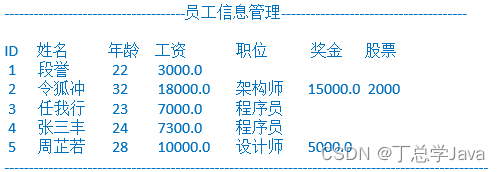
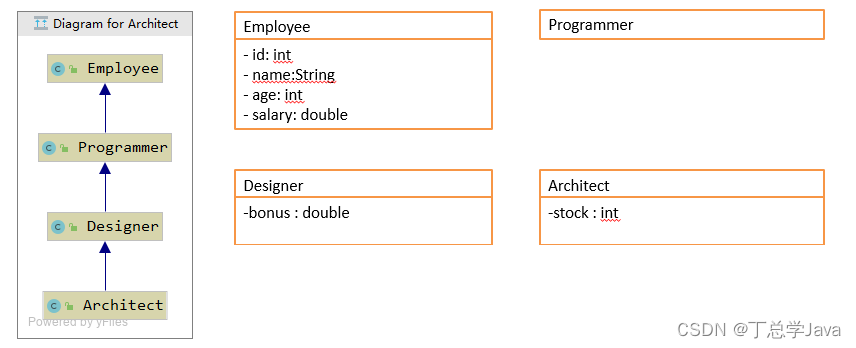
public class Employee {private int id;private String name;// : 姓名private int age;// : 年龄private double salary;// : 工资public Employee() {}public Employee(int id, String name, int age, double salary) {this.id = id;this.name = name;this.age = age;this.salary = salary;}public int getId() {return id;}public void setId(int id) {this.id = id;}public String getName() {return name;}public void setName(String name) {this.name = name;}public int getAge() {return age;}public void setAge(int age) {this.age = age;}public double getSalary() {return salary;}public void setSalary(double salary) {this.salary = salary;}public String say(){return id + "\t\t" + name + "\t" + age + "\t\t" + salary;}public String getInfo() {return say();}
}public class Programmer extends Employee {public Programmer() {}public Programmer(int id, String name, int age, double salary) {super(id, name, age, salary);}@Overridepublic String getInfo() {return super.say() + "\t\t程序员";}
}public class Designer extends Programmer {private double bonus;// : 奖金public Designer() {}public Designer(int id, String name, int age, double salary, double bonus) {super(id, name, age, salary);this.bonus = bonus;}public double getBonus() {return bonus;}public void setBonus(double bonus) {this.bonus = bonus;}@Overridepublic String getInfo() {return super.say() + "\t\t设计师" + "\t" + bonus;}
}public class Architect extends Designer {private int stock;// : 股票public Architect() {}public Architect(int id, String name, int age, double salary, double bonus, int stock) {super(id, name, age, salary, bonus);this.stock = stock;}public int getStock() {return stock;}public void setStock(int stock) {this.stock = stock;}@Overridepublic String getInfo() {return super.say() + "\t\t架构师" + "\t" + getBonus() + "\t" + stock;}
}
public class Exercise20 {public static void main(String[] args) {Employee[] arr = new Employee[5];arr[0] = new Employee(1,"段誉",22,3000);arr[1] = new Architect(2,"令狐冲",32,18000,15000,2000);arr[2] = new Programmer(3,"任我行",23,7000);arr[3] = new Programmer(4,"张三丰",24,7300);arr[4] = new Designer(5,"周芷若",28,10000,5000);System.out.println("----------------员工信息管理-------------------");System.out.println("编号\t姓名\t年龄\t工资\t\t职位\t奖金\t股票");for (int i = 0; i < arr.length; i++) {arr[i].setId(i+1);System.out.println(arr[i].getInfo());}System.out.println("----------------------------------------------");}
}
21、判断运行结果
如下代码是否可以编译通过,如果能,结果是什么,如果不能,为什么?
public class Father{private String name = "atguigu";int age = 0;
}
public class Child extends Father{public String grade;public static void main(String[] args){Father f = new Child();System.out.println(f.name);}
}
public class Child extends Father{public String grade;public static void main(String[] args){Father f = new Child();
// System.out.println(f.name);//编译错误,因为name私有化}
}22、判断运行结果
public class Exercise22 {public static void main(String[] args) {Father f = new Father();Father s = new Son();Father d = new Daughter();MyClass my = new MyClass();/*第一个问题,my有没有多态引用?没有,从my角度来说,不需要考虑多态现象。第二个问题,my调用的method方法,去哪个类找?只MyClass类中找就可以,和其他类无关。第三个问题,method方法有三个形式,即重载的形式,那么怎么确定调用的是哪一个?重载方法找寻原则:A:先找最匹配的什么叫最匹配的?实参的“编译时”类型和形参的“声明”类型一致,个数也一致。B:再找唯一可以兼容的什么叫兼容?实参的“编译时”类型 < 形参的“声明”类型形参是可变参数的话,实参的个数在它允许的范围内*/my.method(f);//father/*实参f的编译时类型是 Father,和哪个方法的形参最匹配呢?public void method(Father f) 就它了*/my.method(s);//father/*实参s的编译时类型是 Father,和哪个方法的形参最匹配呢?public void method(Father f) 就它了*/my.method(d);//father/*实参d的编译时类型是 Father,和哪个方法的形参最匹配呢?public void method(Father f) 就它了*/}
}
class MyClass{public void method(Father f) {System.out.println("father");}public void method(Son s) {System.out.println("son");}public void method(Daughter f) {System.out.println("daughter");}
}
class Father{}
class Son extends Father{}
class Daughter extends Father{}
23、判断运行结果
public class Exercise23 {public static void main(String[] args) {Father f = new Father();Son s = new Son();Daughter d = new Daughter();MyClass my = new MyClass();//my没有多态引用,只看MyClass类就可以了my.method(f);//father/*实参f的编译时类型仍然是Father,找最匹配的public void method(Father f)*/my.method(s);//son/*实参s的编译时类型是Son,找最匹配的public void method(Son s)*/my.method(d);//father/*'实参d的编译时类型是Daughter,找最匹配,没有,找兼容的,public void method(Father f)*/}
}
class MyClass{public void method(Father f) {System.out.println("father");}public void method(Son s) {System.out.println("son");}
}
class Father{}
class Son extends Father{}
class Daughter extends Father{}24、判断运行结果
public class Exercise24 {public static void main(String[] args) {Father f = new Father();Son s = new Son();Daughter d = new Daughter();MyClass my = new MySub();//my有多态引用了,而且method是虚方法/*如何确定它执行的是哪个方法呢?(1)编译时,去my的编译时类型MyClass中找合适的方法(2)运行时,去my的运行时类型MySub中看是否有对刚刚找到的方法进行了“重写”*/my.method(f);//father/*(1)编译时,去my的编译时类型MyClass中找合适的方法实参f的编译时类型是Father,找最匹配的public void method(Father f)(2)运行时,去my的运行时类型MySub中看是否有对刚刚找到的方法进行了“重写”没有重写仍然执行刚刚在MyClass中找到的合适的方法*/my.method(s);//son/*(1)编译时,去my的编译时类型MyClass中找合适的方法实参s的编译时类型是Son,找最匹配的public void method(Son s)(2)运行时,去my的运行时类型MySub中看是否有对刚刚找到的方法进行了“重写”没有重写仍然执行刚刚在MyClass中找到的合适的方法*/my.method(d);//father/*(1)编译时,去my的编译时类型MyClass中找合适的方法实参s的编译时类型是Daughter,找最匹配的,没有,找兼容的,public void method(Father f)(2)运行时,去my的运行时类型MySub中看是否有对刚刚找到的方法进行了“重写”没有重写仍然执行刚刚在MyClass中找到的合适的方法*/}
}
class MyClass{public void method(Father f) {System.out.println("father");}public void method(Son s) {System.out.println("son");}
}
class MySub extends MyClass{public void method(Daughter d) {//这个不是重写,因为形参列表不同System.out.println("daughter");}
}
class Father{}
class Son extends Father{}
class Daughter extends Father{}25、判断运行结果
public class Exercise25 {public static void main(String[] args) {Father f = new Father();Son s = new Son();Daughter d = new Daughter();MyClass my = new MySub();//my有多态引用了,而且method是虚方法/*如何确定它执行的是哪个方法呢?(1)编译时,去my的编译时类型MyClass中找合适的方法(2)运行时,去my的运行时类型MySub中看是否有对刚刚找到的方法进行了“重写”*/my.method(f);//daughter/*(1)编译时,去my的编译时类型MyClass中找合适的方法实参f的编译时类型是Father,找最匹配的public void method(Father f)(2)运行时,去my的运行时类型MySub中看是否有对刚刚找到的方法进行了“重写”有重写一定是执行重写后的代码*/my.method(s);//son/*(1)编译时,去my的编译时类型MyClass中找合适的方法实参s的编译时类型是Son,找最匹配的public void method(Son s)(2)运行时,去my的运行时类型MySub中看是否有对刚刚找到的方法进行了“重写”没有重写仍然执行刚刚在MyClass中找到的合适的方法*/my.method(d);//daughter/*(1)编译时,去my的编译时类型MyClass中找合适的方法实参s的编译时类型是Daughter,找最匹配的,没有,找兼容的,public void method(Father f)(2)运行时,去my的运行时类型MySub中看是否有对刚刚找到的方法进行了“重写”有重写执行的是重写的方法体 daughter*/}
}
class MyClass{public void method(Father f) {System.out.println("father");}public void method(Son s) {System.out.println("son");}
}
class MySub extends MyClass{//有变化public void method(Father d) {//是重写System.out.println("daughter");}
}
class Father{}
class Son extends Father{}
class Daughter extends Father{}
26、判断运行结果
考核点:属性与多态无关
public class Exercise26 {public static void main(String[] args) {A a = new B();System.out.println(a.num);System.out.println(((B)a).num);System.out.println(((A)((B)a)).num);System.out.println("-------------------");B b = new B();System.out.println(b.num);System.out.println(((A)b).num);System.out.println(((B)((A)b)).num);}
}
class A{int num = 1;
}
class B extends A{int num = 2;
}
/** 多态性现象:编译时类型与运行时类型不一致* 但是多态性是针对方法来说,方法有动态绑定一说。* 属性没有多态性。属性都是按照编译时类型处理的。*/
public class Exercise26 {public static void main(String[] args) {A a = new B();System.out.println(a.num);//a编译时类型就是A 1System.out.println(((B)a).num);//编译后,因为a被强制成B类,是B类型 2System.out.println(((A)((B)a)).num);//编译后,a转成B又转成A,是A类型 1System.out.println("-------------------");B b = new B();System.out.println(b.num);//b编译时类型就是B 2System.out.println(((A)b).num);//b被强制升级为A类型,按A类型处理, 1System.out.println(((B)((A)b)).num);//b先转A又转B,最终是B类型 2}
}
class A{int num = 1;
}
class B extends A{int num = 2;
}
27、判断运行结果
考核点:实例初始化方法,属性与多态无关
public class Exercise27 {public static void main(String[] args) {Father f = new Son();System.out.println(f.x);}
}
class Father{int x = 10;public Father(){this.print();x = 20;}public void print(){System.out.println("Father.x = " + x);}
}
class Son extends Father{int x = 30;public Son(){this.print();x = 40;}public void print(){System.out.println("Son.x = " + x);}
}
/** 1、Father f = new Son();* 实例初始化的过程:* (1)父类的实例初始化* <init>(){* x = 10;//父类的x* this.print();//子类的print,因为this代表的是正在创建的子类对象,而子类重写了print,所以是子类的print'* System.out.println("Son.x = " + x);//子类的x,此时还没有赋值,那么是默认值x=0x = 20;//父类的x* }* (2)子类的实例初始化* <init>(){* x = 30;//子类的x* this.print();//子类的print* System.out.println("Son.x = " + x);//子类的x,此时已经赋值x=30x = 40;//子类的x* }* * 2、执行System.out.println(f.x);* 属性没有多态性,只看编译时类型,那么此时f.x表示父类的x*/
public class Exercise27 {public static void main(String[] args) {Father f = new Son();System.out.println(f.x);}
}
class Father{int x = 10;public Father(){this.print();x = 20;}public void print(){System.out.println("Father.x = " + x);}
}
class Son extends Father{int x = 30;public Son(){this.print();x = 40;}public void print(){System.out.println("Son.x = " + x);}
}
28、判断运行结果
考核点:多态,重写,实例初始化过程
public class Exercise28 {public static void main(String[] args) {Base b1 = new Base();Base b2 = new Sub();}
}class Base {Base() {method(100);}public void method(int i) {System.out.println("base : " + i);}
}class Sub extends Base {Sub() {super.method(70);}public void method(int j) {System.out.println("sub : " + j);}
}
/** 1、Base b1 = new Base();* 父类的实例初始化,和子类无关* * <init>(){* method(100);* System.out.println("base : " + i); base:100* }* * 2、Base b2 = new Sub();* (1) 父类的实例初始化* * <init>(){* method(100);//执行了子类重写的method()* System.out.println("sub : " + j); sub:100* }* * (2)子类的实例初始化* <init>(){* super.method(70);* System.out.println("base : " + i); base:70* }*/
public class Exercise28 {public static void main(String[] args) {Base b1 = new Base();Base b2 = new Sub();}
}class Base {Base() {method(100);}public void method(int i) {System.out.println("base : " + i);}
}class Sub extends Base {Sub() {super.method(70);}public void method(int j) {System.out.println("sub : " + j);}
}
29、判断运行结果
考核知识点:多态、重载、重写
public class Exercise29 {public static void main(String[] args) {A a1 = new A();A a2 = new B();B b = new B();C c = new C();D d = new D();System.out.println("(1)" + a1.show(b));System.out.println("(2)" + a2.show(d));System.out.println("(3)" + b.show(c));System.out.println("(4)" + b.show(d));}
}
class A{public String show(D obj){return ("A and D");}public String show(A obj){return "A and A";}
}
class B extends A{public String show(B obj){return "B and B";}public String show(A obj){return "B and A";}
}
class C extends B{}
class D extends B{}
/** 1、分析方法列表和继承关系* A类:* public String show(D obj) * public String show(A obj)* B类:* public String show(D obj)继承的* public String show(A obj)重写* public String show(B obj)自定义的* C->B->A* D->B->A* * 2、方法重载:找最合适的形参类型* 3、方法重写:如果子类重写,就执行重写的* 4、分析执行结果* a1.show(b):a1没有多态引用,直接找A类的方法,b是B类对象,只能选择public String show(A obj) A and A* a2.show(d):a2多态引用,执行子类的方法,d是D类对象,选最合适的public String show(D obj) A and D* b.show(c):b没有多态引用,直接找B类的方法,c是C类的对象,选择最合适的public String show(B obj) B and B* b.show(d):b没有多态引用,直接找B类的方法,d是D类对象,选最合适的public String show(D obj) A and D*/
public class Exercise29 {public static void main(String[] args) {A a1 = new A();A a2 = new B();B b = new B();C c = new C();D d = new D();System.out.println("(1)" + a1.show(b));System.out.println("(2)" + a2.show(d));System.out.println("(3)" + b.show(c));System.out.println("(4)" + b.show(d));}
}class A {public String show(D obj) {return ("A and D");}public String show(A obj) {return "A and A";}
}class B extends A {public String show(B obj) {return "B and B";}public String show(A obj) {return "B and A";}
}class C extends B {}class D extends B {}
30、判断运行结果
考核知识点:多态、重载、重写
public class Exercise30 {public static void main(String[] args) {A a1 = new A();A a2 = new B();B b = new B();C c = new C();D d = new D();System.out.println("(1)" + a1.show(b));System.out.println("(2)" + a2.show(d));System.out.println("(3)" + b.show(c));System.out.println("(4)" + b.show(d));}
}class A {public String show(C obj) {return ("A and C");}public String show(A obj) {return "A and A";}
}class B extends A {public String show(B obj) {return "B and B";}public String show(A obj) {return "B and A";}
}class C extends B {}class D extends B {}
/** 1、分析每个类的方法列表和继承关系* A类:* public String show(C obj) * public String show(A obj)* B类:* public String show(C obj)继承的* public String show(A obj)重写* public String show(B obj)自定义的* C->B->A* D->B->A* * 2、方法重载:找最合适的形参类型* 3、方法重写:如果子类重写,就执行重写的* 4、如果特殊的重载,那么多态时,编译时先从父类中查找最合适的形参类型,然后如果子类如果有重写,执行子类重写的,如果没有重写,执行父类的。* 5、分析执行结果* a1.show(b):a1没有多态引用,直接找A类的方法,b是B类对象,只能选择public String show(A obj) A and A* a2.show(d):a2多态引用,执行子类的方法,d是D类对象,但是因为此时编译时按A类编译,所以在编译期间先确定是调用* public String show(A obj),而后执行子类重写的public String show(A obj) B and A* 而不是直接选最合适的public String show(B obj)* b.show(c):b没有多态引用,直接找B类的方法,c是C类的对象,选择最合适的public String show(C obj) A and C* b.show(d):b没有多态引用,直接找B类的方法,d是D类对象,选最合适的public String show(B obj) B and B*/
public class Exercise30 {public static void main(String[] args) {A a1 = new A();A a2 = new B();B b = new B();C c = new C();D d = new D();System.out.println("(1)" + a1.show(b));System.out.println("(2)" + a2.show(d));System.out.println("(3)" + b.show(c));System.out.println("(4)" + b.show(d));}
}class A {public String show(C obj) {return ("A and C");}public String show(A obj) {return "A and A";}
}class B extends A {public String show(B obj) {return "B and B";}public String show(A obj) {return "B and A";}
}class C extends B {}class D extends B {}
31、判断运行结果
考核点:属性与多态无关
public class Exercise31 {public static void main(String[] args) {Base b = new Sub();System.out.println(b.x);}
}
class Base{int x = 1;
}
class Sub extends Base{int x = 2;
}
/** 属性没有多态性,只看编译时类型*/
public class Exercise31 {public static void main(String[] args) {Base b = new Sub();System.out.println(b.x);}
}
class Base{int x = 1;
}
class Sub extends Base{int x = 2;
}
32、判断运行结果
/*
下面这些代码,调用的都是成员变量,不是虚方法。
只看变量或对象的“编译时类型”就可以了。
什么是编译时类型?
(1)对于变量来说,变量声明时,左边的类型就是它的编译时类型
(2)对于强制类型转换来说,()中写的类型是什么,它的编译时类型就是什么。如果有连续多次的强制类型转换,看最后一次。*/
public class Exercise32 {public static void main(String[] args) {A a = new B();System.out.println(a.num);//a变量的编译时类型是A//1System.out.println(((B)a).num);//((B)a),的编译时类型就是B//2System.out.println(((A)((B)a)).num);//((A)((B)a)),最后的类型是(A),它的编译时类型就是A//1System.out.println("-------------------");B b = new B();System.out.println(b.num);//b变量的编译时类型是B//2System.out.println(((A)b).num);//((A)b),编译时类型是A//1System.out.println(((B)((A)b)).num);//((B)((A)b)),编译时类型B//2}
}
class A{int num = 1;
}
class B extends A{int num = 2;
}
06-Object类
33、Triangle类
声明三角形类Triangle
(1)属性:double类型的a,b,c,代表三角形的三条边,要求属性使用final声明,并且私有化
(2)提供有参构造,并且在构造器中检查a,b,c是否可以构成三角形,如果a,b,c可以构成三角形则正常赋值,否则提示错误,并且a,b,c赋值为0
(3)生成a,b,c的get方法
(4)重写toString方法,并返回三角形信息,例如:“三角形三边是:3.0,4.0,5.0,面积是6.0,周长是:12.0”
(5)重写hashCode和equals方法
(6)编写 public double getArea():求面积方法
(7)编写 public double getPiremeter():求周长方法
在测试类的main中创建两个三角形对象,a,b,c分为赋值为3,4,5,调用equals方法比较两个对象是否相等,打印两个对象看结果。
public class Triangle {private final double a;private final double b;private final double c;public Triangle(double a, double b, double c) {if(a<=0 || b<=0 || c<=0 || a+b<=c || a+c<=b || b+c<=a){System.out.println(a+ "," +b +"," + c +"无法构成三角形");this.a = 0;this.b = 0;this.c = 0;}else{this.a = a;this.b = b;this.c = c;}}public double getA() {return a;}public double getB() {return b;}public double getC() {return c;}public double area(){double p = (a+b+c)/2;return Math.sqrt(p*(p-a)*(p-b)*(p-c));}public double perimeter(){return a+b+c;}@Overridepublic String toString(){return "三角形三边是:"+ a+ "," +b +"," + c +",面积是" + area() +",周长是:" + perimeter();}@Overridepublic boolean equals(Object o) {if (this == o) return true;if (o == null || getClass() != o.getClass()) return false;Triangle triangle = (Triangle) o;return Double.compare(triangle.a, a) == 0 &&Double.compare(triangle.b, b) == 0 &&Double.compare(triangle.c, c) == 0;}@Overridepublic int hashCode() {return Objects.hash(a, b, c);}
}public class Exercise33 {public static void main(String[] args) {Triangle t1 = new Triangle(3,4,5);Triangle t2 = new Triangle(3,4,5);System.out.println(t1.equals(t2));System.out.println(t1);System.out.println(t2);}
}






![【Dart】=> [05] Dart初体验-函数](http://pic.xiahunao.cn/【Dart】=> [05] Dart初体验-函数)




,以及全真模拟题)



)
技术的原理与实践)

